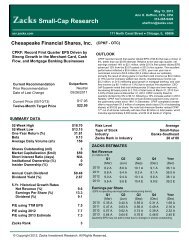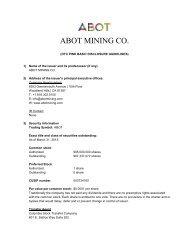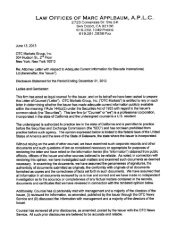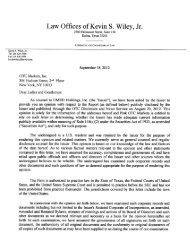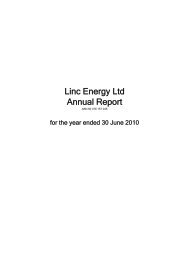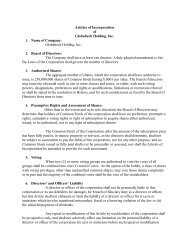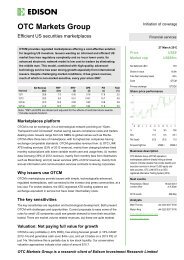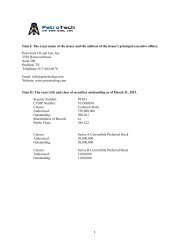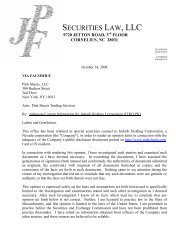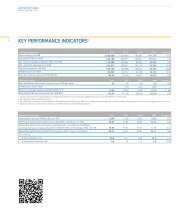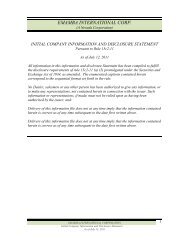2011 Annual Report - OTCIQ.com
2011 Annual Report - OTCIQ.com
2011 Annual Report - OTCIQ.com
Create successful ePaper yourself
Turn your PDF publications into a flip-book with our unique Google optimized e-Paper software.
206 Glossary of Financial Terms<br />
EBIT<br />
Adjusted earnings before interest and taxes. It is derived from<br />
in<strong>com</strong>e/loss from continuing operations before interest in<strong>com</strong>e<br />
and in<strong>com</strong>e taxes and is adjusted to exclude certain extraordinary<br />
items, mainly other in<strong>com</strong>e and expenses of a nonrecurring<br />
or rare nature (see Other non-operating earnings).<br />
EBITDA<br />
Adjusted earnings before interest, taxes, depreciation, and<br />
amortization. E.ON’s key earnings figure for purposes of internal<br />
management control and as an indicator of our businesses’<br />
long-term earnings power. It is derived from in<strong>com</strong>e/<br />
loss from continuing operations before interest in<strong>com</strong>e and<br />
in<strong>com</strong>e taxes and is adjusted to exclude certain extraordinary<br />
items, mainly other in<strong>com</strong>e and expenses of a non-recurring<br />
or rare nature (see Other non-operating earnings).<br />
Economic net debt<br />
Key figure that supplements net financial position with pension<br />
obligations and asset retirement obligations (less prepayments<br />
to the Swedish nuclear fund). The calculation of economic<br />
net debt includes the fair value (net) of currency derivatives<br />
used for financing transactions (but excluding transactions<br />
relating to our operating business and asset management)<br />
in order to also reflect the foreign-currency effects of financial<br />
transactions which, for accounting reasons, would not be<br />
included in the <strong>com</strong>ponents of net financial position.<br />
Equity method<br />
Method for valuing shareholdings in associated <strong>com</strong>panies<br />
whose assets and liabilities are not fully consolidated. The proportional<br />
share of the <strong>com</strong>pany’s annual net in<strong>com</strong>e (or loss)<br />
is reflected in the shareholding’s book value. This change is<br />
usually shown in the owning <strong>com</strong>pany’s in<strong>com</strong>e statement.<br />
Fair value<br />
The price at which assets, debts, and derivatives pass from a<br />
willing seller to a willing buyer, each having access to all the<br />
relevant facts and acting freely.<br />
Financial derivative<br />
Contractual agreement based on an underlying value (reference<br />
interest rate, securities prices, <strong>com</strong>modity prices) and a<br />
nominal amount (foreign currency amount, a certain number<br />
of stock shares).<br />
Goodwill<br />
The value of a subsidiary as disclosed in the parent <strong>com</strong>pany’s<br />
consolidated financial statements resulting from the consolidation<br />
of capital (after the elimination of hidden reserves and<br />
liabilities). It is calculated by offsetting the carrying amount<br />
of the parent <strong>com</strong>pany’s investment in the subsidiary against<br />
the parent <strong>com</strong>pany’s portion of the subsidiary’s equity.<br />
Impairment test<br />
Periodic <strong>com</strong>parison of an asset’s book value with its fair<br />
value. A <strong>com</strong>pany must record an impairment charge if it<br />
determines that an asset’s fair value has fallen below its<br />
book value. Goodwill, for example, is tested for impairment<br />
on at least an annual basis.<br />
International Financial <strong>Report</strong>ing Standards (“IFRS”)<br />
Under regulations passed by the European Parliament and<br />
European Council, capital-market-oriented <strong>com</strong>panies in<br />
the EU must apply IFRS for fiscal years that begin on or after<br />
January 1, 2005, and by January 1, 2007, at the latest.<br />
Investments<br />
Cash-effective capital investments.<br />
Net financial position<br />
Difference between a <strong>com</strong>pany’s total financial assets (cash<br />
and securities) and total financial liabilities (debts to financial<br />
institutions, third parties, and associated <strong>com</strong>panies).<br />
Option<br />
The right, not the obligation, to buy or sell an underlying asset<br />
(such as a security or currency) at a specific date at a predetermined<br />
price from or to a counterparty or seller. Buy options<br />
are referred to as calls, sell options as puts.<br />
Other non-operating earnings<br />
In<strong>com</strong>e and expenses that are unusual or infrequent, such as<br />
book gains or book losses from significant disposals as well<br />
as restructuring expenses (see EBIT).



